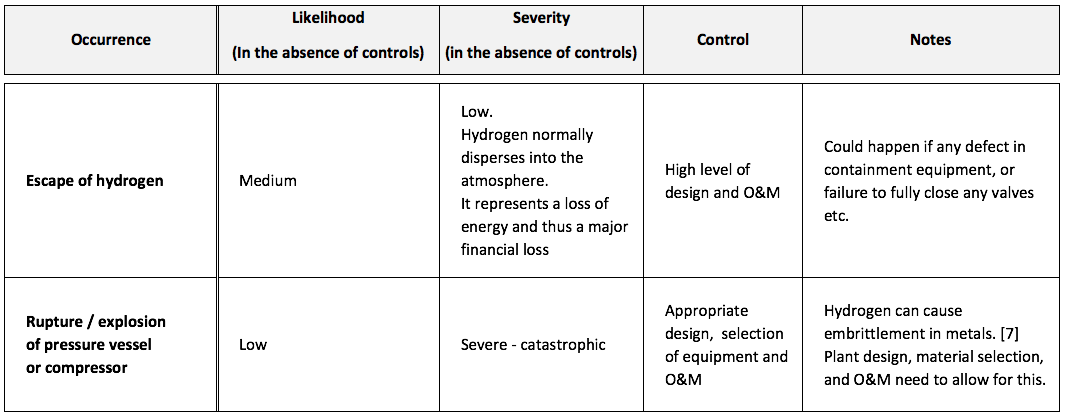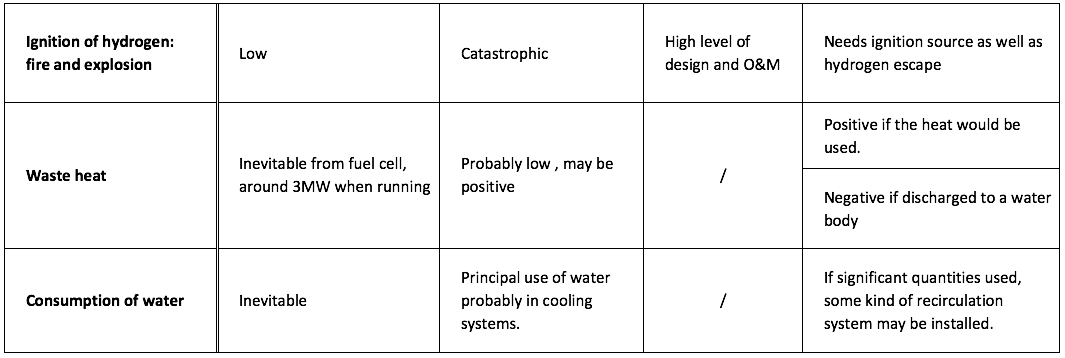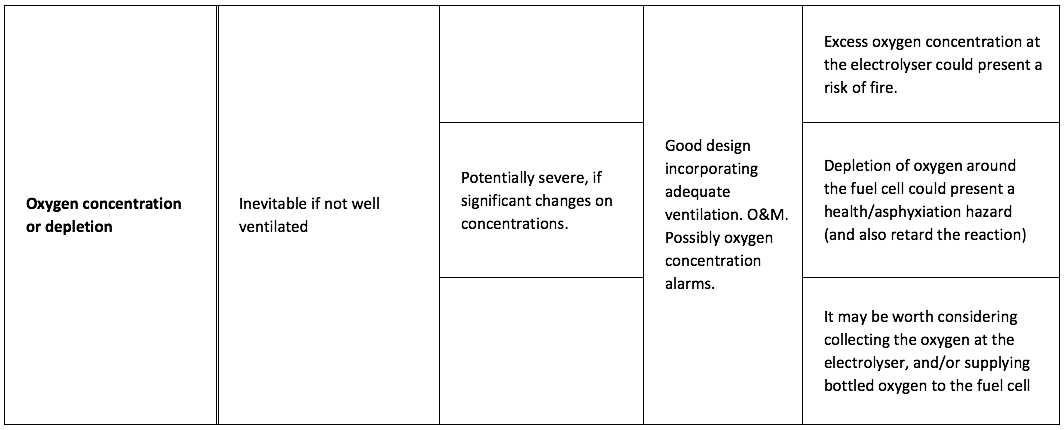|
Practical and environmental considerations of the Hydrogen Peak power Plant were not key aims of the project, and have not been evaluated in detail. However, some brief comments are included below.
Practical ConsiderationsWhat statutory permissions would be needed to build Hydrogen Peak Power Plant?
For any type of permission, the complexity increases with size of plant.Building plant of a relatively small modular size is considered to be relatively simple from a Planning and Permitting point of view.
It would be prudent to contact SEPA at an early stage, to check any requirements they may have can be designed in from the beginning.
Some authors consider the risks associated with hydrogen plant are comparable with those associated with fossil fuels [4]. Liquid fuel refiling stations are common in town centres. In the future, if hydrogen-based systems become widespread, and maintain a good safety record, they may indeed become commonplace in urban areas. Would any back-up generation be needed?
If the plant is to be in a contract to supply energy at very short notice, it is possible there may not be cheap energy available to refill the hydrogen store every time the plant is required to supply electricity to the grid. It may be advantageous to have some kind of backup generation for use if the main plant cannot run, or it is particularly uneconomic to do so.
Renewable generation wind and solar were eliminated because they cannot be relied upon. It was considered a generator, ideally using a biofuel, could provide reliable despatchable backup. This option was not considered in detail, but is an avenue for further study. Environmental Considerations
The assessment of environmental sustainability is beyond the scope of this project. Several factors would need consideration:
Energy consumption, carbon emissions
When the electricity used is being supplied from electricity grid, it cannot be claimed that the system has zero carbon emission. When the UK is considered, average carbon intensity of the UK grid is around 400 g of CO2 / kWh [5]. Thus, when the grid electricity is used to refill our system, the system would have an impact on carbon emission rates. However, the system is not a stand-alone carbon generator, so a future, more decarbonized grid, will allow the hydrogen peak power plant to be a more carbon-efficient system. The projection of carbon intensity of the UK electricity grid according to different kinds of scenarios is shown on the graph below.
At first sight, a storage system which requires far more energy than it can produce, would not be appear to be environmentally sustainable. However, it is necessary to examine the system and its context in closer detail. If:
then, in those circumstances, it is questionable whether the consumption of such electricity actually has a significant environmental impact. Indeed, such storage plants could facilitate further penetration of renewable energy into the grid, stabilise the grid[6], and potentially reduce or avoid the need for peak power plants which use fossil fuels (such as fast start-up gas or diesel plants). As such, storage plants could bring wider CO2 emissions savings and facilitate the decarbonisation of the grid and its robustness. Furthermore, other possible applications, such as use in the transport sector, described separately, may further improve the environmental viability of this type of plant. Other environmental impacts
Clearly, one cannot assume there will be no environmental impacts. As is the case with many types of industrial plant, there are environmental and safety risks which must be managed, to avoid or minimise impacts. Hydrogen does not have toxicity hazards associated with some battery technologies, however other types of impacts could occur without adequate controls.
A brief indication of the some potential risks which would need to be managed are tabulated below, with an indication of possible likelihood, severity and suggested controls. Life Cycle Assessment Life Cycle Assessment of the PPP is beyond the scope of the project. Some types of electrolysers and fuel cells (PEM) use platinum group metals, as current technology requires their corrosion-resistant properties to operate in the acidic conditions of this type of equipment. Extraction of such metals may incur impacts, and these metals may be prone to scarcity and price rises.
Some authors have found hydrogen to compare favourably to battery systems from a lifetime energy consumption approach [8]. Environmental Sustainability
In short, the environmental sustainability, or otherwise, of this plant, depends very strongly on its context, source of electricity, mode of use, the way in which it is operated, and type of plant selected. This evaluation is not simple.
This plant is believed to have the potential to contribute to increased environmental sustainability, in some circumstances. A detailed analysis of this topic would be an interesting area for further study. [1] "Pollution Prevention and Control Regulations (Scotland) 2012," ed, 2012.
[2] SEPA. (2013). Pollution Prevention and Control. Available: http://www.sepa.org.uk/regulations/pollution-prevention-and-control/ [3] SEPA. (not dated). Renewable / hydrogen. Available: http://www.sepa.org.uk/environment/energy/renewable/#hydrogen [4] A. Godula-Jopek, Introduction. In: "Hydrogen production by electrolysis" ed. A. Godula-Jopek. Weinheim, Germany: Wiley-VCH, 2014. [5] Committee on Climate Change. (2013). Fourth carbon budget technical report. Sectoral analysis of the cost-effective path to the 2050 budget. Chapter 2: reducing emission from the power sector. Available: https://www.theccc.org.uk/wp-content/uploads/2013/12/1785b-CCC_TechRep_Singles_Chap2_1.pdf [6] House of Lords Science and Technology Select Committee. (2015). The Resilience of the UK Electricity System. Available: http://www.publications.parliament.uk/pa/ld201415/ldselect/ldsctech/121/12104.htm#a8 [7] A. Godula-Jopek, Hydrogen storage options including constraints and challenges. In: "Hydrogen production by electrolysis", ed. A. Godula-Jopek. Weinheim, Germany: Wiley - VCH, 2014. [8] M. A. Pellow, C. J. M. Emmott, C. J. Barnhart, and S. M. Benson, "Hydrogen or batteries for grid storage? A net energy analysis," Energy and Environmental Science, vol. 8, pp. 1938-1952, 2015. |
H3P PROJECT - Modular Peak Power Plant




